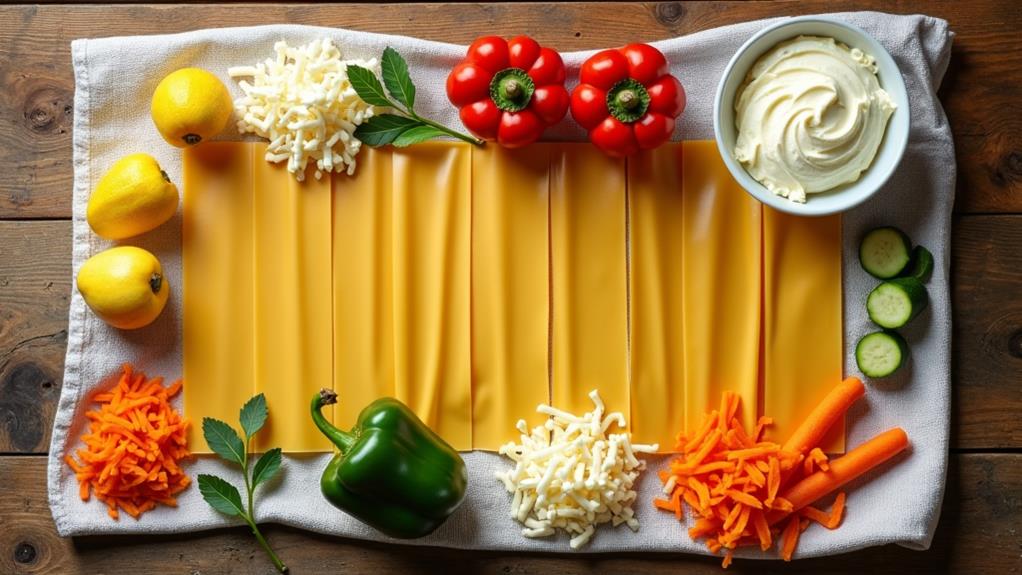Imagine a family gathering where the centerpiece is a warm winter vegetable lasagna, filled with vibrant layers of seasonal produce. You might wonder how such a dish not only satisfies diverse palates but also highlights the best of winter's bounty. As you consider the balance of flavors and textures, it's worth exploring the origins of this comfort food and how it has evolved over time. What ingredients might elevate your own version, and how can you adapt it to meet specific dietary needs?
Key Takeaways
- Winter vegetable lasagna features layers of roasted seasonal vegetables, ricotta, and mozzarella cheese, making it a hearty comfort dish.
- Homemade tomato sauce enhances the flavor and nutritional value of the lasagna, adding wholesomeness to each bite.
- The dish is versatile, accommodating dietary preferences by using gluten-free noodles or incorporating different cheeses and herbs.
- Preparation involves roasting vegetables, mixing ricotta with seasonings, and layering ingredients before baking for optimal flavor and texture.
- Leftovers can be refrigerated or frozen, offering a convenient meal prep option for busy weeknights.
History
Lasagna has a rich history that dates back thousands of years, with its roots traced to Ancient Greece. You might be surprised to learn that the original dish, called "Laganon," featured layers of pasta and sauce, setting the stage for what we now know as lasagna.
As time went on, this delicious dish evolved in Italy during the Middle Ages, where ingredients like cheese and meat were added, giving rise to various regional recipes.
One of the most famous is "Lasagna alla Bolognese," a hearty combination of pasta, meat ragu, béchamel sauce, and cheese, which became a beloved dish in the Emilia-Romagna region.
When Italian immigrants brought lasagna to the United States, particularly to Italian-American communities, it took on new forms.
Today, many people enjoy winter vegetable lasagna, a modern twist on traditional recipes. This version often incorporates seasonal vegetables like Butternut squash, creating a nutritious and hearty meal perfect for chilly days.
Recipe

Winter Vegetable Lasagna
Winter Vegetable Lasagna is a comforting and hearty dish perfect for chilly evenings. This lasagna is packed with layers of roasted vegetables, creating a colorful and nutritious meal. The combination of bell peppers, zucchini, and carrots enhances the flavor, while the creamy ricotta adds richness. With its homemade tomato sauce, this dish isn't only wholesome but also a delightful centerpiece for any winter gathering.
Making this lasagna is convenient, as it can be prepared in advance. You can assemble it the night before and refrigerate it until you're ready to bake, or even freeze it for future meals. Using no-boil lasagna noodles streamlines the process, allowing the noodles to absorb moisture from the sauce, guaranteeing a perfect texture once baked. This adaptable recipe can also cater to various dietary preferences, making it a versatile choice for everyone at the table.
Ingredients:
- 9 no-boil lasagna noodles
- 1 medium bell pepper, diced
- 1 medium zucchini, sliced
- 2 medium carrots, grated
- 2 cups homemade tomato sauce
- 1 cup ricotta cheese
- 2 cups shredded mozzarella cheese
- 1 teaspoon dried oregano
- 1 teaspoon salt
- 1/2 teaspoon black pepper
- Olive oil for roasting
Instructions:
Preheat your oven to 375°F (190°C). In a large bowl, toss the diced bell pepper, sliced zucchini, and grated carrots with olive oil, salt, and pepper. Spread the vegetables on a baking sheet and roast for about 25 minutes until tender.
In a separate bowl, mix the ricotta cheese with oregano and a pinch of salt. In a 9×13 inch baking dish, spread a thin layer of tomato sauce on the bottom, then layer 3 no-boil noodles, half of the roasted vegetables, half of the ricotta mixture, and a third of the mozzarella cheese.
Repeat the layering process, finishing with noodles and a generous layer of tomato sauce topped with the remaining mozzarella. Cover with foil and bake for 30 minutes, then remove the foil and bake for an additional 15-20 minutes until bubbly and golden.
Extra Tips:
To guarantee your lasagna turns out perfectly, make sure to cover the noodles completely with sauce to allow them to cook properly during baking. If you're using gluten-free noodles, check the cooking instructions on the package, as some may require different preparation.
For added flavor, consider incorporating fresh herbs like basil or thyme into the layers or using a blend of cheeses for a richer taste.
If you enjoy this dish, you might also like vegetable stuffed shells, ratatouille, or a classic vegetable moussaka, all of which feature similar ingredients and flavors.
Final Notes
When it comes to winter vegetable lasagna, you'll find it's not just a delicious meal but also a flexible recipe that adapts well to your tastes and dietary needs. This vegetable lasagna recipe is a true comfort food, packed with seasonal vegetables like bell peppers, zucchini, and spinach, which are perfect for adding nutrients during the colder months.
If you're looking to cater to gluten sensitivities, simply swap out traditional noodles for gluten-free lasagna noodles, and you've got a dish everyone can enjoy.
Don't forget about that homemade tomato sauce! Simmering onion, garlic, and herbs together creates a rich flavor that elevates your lasagna. Plus, it's easy to make ahead and freeze for future meals.
Layer your roasted veggies and creamy ricotta cheese in the final layer, and you'll have a healthy meal that's bursting with flavor.
The great thing about winter vegetable lasagna is its practicality. You can easily prepare it for meal prep, refrigerate leftovers, or even freeze them for busy nights.
